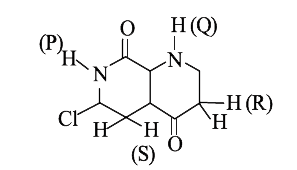An acid-base indicator has Ka=10−5. The acid form of the indicator is red and basic form is blue. Which of the following is//are correct?
At pH=4.52, solution is red
At pH−5.47, solution is blue.
At pH=6, solution is 75% red
At pH=8, solution is 75% blue.
The correct Answer is:A, B
To solve the question regarding the acid-base indicator with a given Ka=10−5, we will follow these steps:
Step 1: Write the dissociation reaction of the indicator
The indicator can be represented as:
H-I-N⇌H++I-N−
Where:
- H-I-N is the acidic form (red)
- I-N− is the basic form (blue)
Step 2: Calculate the pKa
Using the formula:
pKa=−log(Ka)
Substituting the given Ka:
pKa=−log(10−5)=5
Step 3: Analyze the color of the solution based on pH
- If pH<pKa (i.e., pH < 5), the acidic form predominates, and the solution will be red.
- If pH>pKa (i.e., pH > 5), the basic form predominates, and the solution will be blue.
Step 4: Evaluate the options given in the question
Option A: pH 4.52 (Solution is red)
- 4.52<5 (pH < pK_a)
- Correct: The solution is red.
Option B: pH 5.47 (Solution is blue)
- 5.47>5 (pH > pK_a)
- Correct: The solution is blue.
Option C: pH 6 (Solution is 75% red)
- 75% red means 75% acidic and 25% basic.
- Using the Henderson-Hasselbalch equation:
pH=pKa+log(baseacid)
pH=5+log(0.250.75)
Calculating:
pH=5+log(13)≈5−0.477=4.52
- However, the question states pH is 6, which is incorrect.
Option D: pH 8 (Solution is 75% blue)
- 75% blue means 75% basic and 25% acidic.
- Using the Henderson-Hasselbalch equation:
pH=5+log(0.750.25)
Calculating:
pH=5+log(3)≈5+0.477=5.477
- However, the question states pH is 8, which is incorrect.
Conclusion
The correct options are:
- Option A: Correct
- Option B: Correct
- Option C: Incorrect
- Option D: Incorrect
Final Answer
The correct statements are Option A and Option B.
---
The indicator can be represented as:
H-I-N⇌H++I-N−
Where:
- H-I-N is the acidic form (red)
- I-N− is the basic form (blue)
Using the formula:
pKa=−log(Ka)
Substituting the given Ka:
pKa=−log(10−5)=5
- If pH<pKa (i.e., pH < 5), the acidic form predominates, and the solution will be red.
- If pH>pKa (i.e., pH > 5), the basic form predominates, and the solution will be blue.
- 4.52<5 (pH < pK_a)
- Correct: The solution is red.
- 5.47>5 (pH > pK_a)
- Correct: The solution is blue.
- 75% red means 75% acidic and 25% basic.
- Using the Henderson-Hasselbalch equation:
pH=pKa+log(baseacid)
pH=5+log(0.250.75)
Calculating:
pH=5+log(13)≈5−0.477=4.52
- However, the question states pH is 6, which is incorrect.
- 75% blue means 75% basic and 25% acidic.
- Using the Henderson-Hasselbalch equation:
pH=5+log(0.750.25)
Calculating:
pH=5+log(3)≈5+0.477=5.477
- However, the question states pH is 8, which is incorrect.
The correct options are:
- Option A: Correct
- Option B: Correct
- Option C: Incorrect
- Option D: Incorrect
The correct statements are Option A and Option B.
Topper's Solved these Questions
- IONIC EQUILIBRIUMBOOK - CENGAGE CHEMISTRY ENGLISHCHAPTER - IONIC EQUILIBRIUMEXERCISE - Exercises Single Correct
121 Videos
- IONIC EQUILIBRIUMBOOK - CENGAGE CHEMISTRY ENGLISHCHAPTER - IONIC EQUILIBRIUMEXERCISE - Exercises Assertion-Reasoning
36 Videos
- IONIC EQUILIBRIUMBOOK - CENGAGE CHEMISTRY ENGLISHCHAPTER - IONIC EQUILIBRIUMEXERCISE - Exercises Linked Comprehension
45 Videos
- HYDROGEN, WATER AND HYDROGEN PEROXIDEBOOK - CENGAGE CHEMISTRY ENGLISHCHAPTER - HYDROGEN, WATER AND HYDROGEN PEROXIDEEXERCISE - Subjective Archive (Subjective)
3 Videos
- ISOMERISMBOOK - CENGAGE CHEMISTRY ENGLISHCHAPTER - ISOMERISMEXERCISE - Assertion-Reasoning Type
1 Videos
Similar Questions
An acid-base indicator has Ka=3.0×10−5. The acid form of the indicator is red and the basic form is blue. Then:
View SolutionAn acid-base indicator has a Ka=3.0×10−5. The acid form of the indicator is red and the basic form is blue. Then
View SolutionAn acid-base indicator has a Ka of 3.0×10−5. The acid form of the indicator is red and the basic form is blue. (a) By how much must the pH change in order to change the indicator from 75% red to 75% blue?
View SolutionAn acid base indicator has Ka=1.0×10−5 the acid form of the indicator is red and the basic form is blue. Calculate the pH change required to change the colour of the indicator from 80% red to 80% blue.
View SolutionThe ionisation constant of an acid base indicator (a weak acid) is 1.0×10−6. The ionised form of the indicator is red and unionised form is blue. The pH change required to alter the colour of indicator from 80% red to 20% red is
View SolutionIn an acidic indicator HIn has an ionization constant is 10−8. The acid form of indicator is yellow and alkaline form is red. Which is correct statement?
(Given : log2= 0.3, log3 = 0.48)
View SolutionBromothymol blue is an indicator with a Ka value of 6×10−5. What % of this indicator is in its basic form at a pH of 5 ?
View SolutionAn acid indicator is represented by Hln.(Ka=10−5). The range of change of colour for the indicator is
View Solutionwhich of the indicated 'H' is most acidic ?

View SolutionCyanohydrin of which of the following forms lactic acid
View Solution
